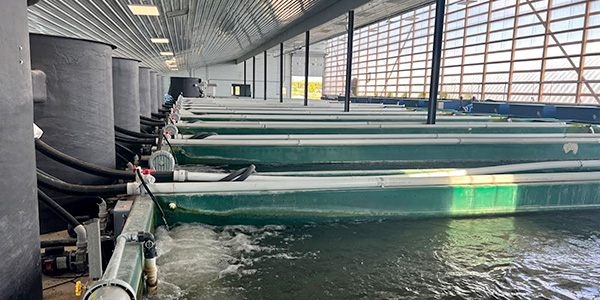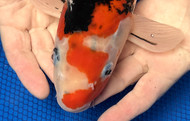From Fingerling to Giant: Understanding Koi Fish Growth
Posted by Kloubec Koi Farm on 8th Sep 2025
Koi fish growth from fingerling to giant size requires careful attention to specific conditions and proper care techniques. These ornamental carp start as tiny fry, requiring temperatures between 59-77°F and pristine water quality with pH levels of 7.5-8.0. Through structured feeding programs and adequate space (one koi per 200 gallons), they can grow 1-2 inches monthly, potentially reaching lengths of 36 inches. Young koi typically achieve 8 inches in their first year, with continued growth throughout their 20+ year lifespan. Success depends on balanced nutrition, proper tank dimensions, and consistent health monitoring. Mastering these essential elements reveals the full potential of these magnificent aquatic specimens.
Early Growth Stages
The first five days of a koi fish's life are essential, beginning with the hatching process from fertilized eggs. During this delicate period, proper tank setup and environmental impact play significant roles in survival rates. At Kloubec Koi Farm, strict health protocols guarantee ideal conditions for developing fry. Once hatched, these tiny swimmers immediately begin their remarkable journey through various developmental milestones.
Around the one-week mark, fascinating behavioral changes occur as koi fry develop their air bladders, transforming them from awkward drifters into capable swimmers. This adaptation allows them to explore their environment more efficiently and access food at the water's surface. Successful breeding techniques incorporate specialized feeding schedules, starting with infusoria (microscopic water life) and gradually progressing to micro-particles that support rapid growth.
Ideal Growing Conditions
Creating ideal growing conditions for koi requires careful attention to three fundamental environmental parameters: water temperature, pH levels, and spatial requirements. To guarantee peak growth, maintain water temperature between 59 and 77°F (15-25°C), as this range supports healthy metabolic function and steady development. The pH balance should stay between 7.5 and 8, creating a stable environment where koi can thrive and grow to their full potential.
Space management plays a significant role in koi development, with proper stocking density being essential for healthy growth. Following the guideline of one koi per 200 gallons helps prevent overcrowding and reduces stress on these majestic fish. When planning your pond or tank size, remember that koi can grow up to three feet in length, making a minimum capacity of 1,000 gallons necessary for juvenile specimens. Regular water quality monitoring rounds out these ideal conditions, with consistent testing for ammonia, nitrite, nitrate, and dissolved oxygen levels. Think of it as creating a five-star hotel for your finned friends - they'll reward your attention to detail with vibrant colors and robust growth.
Feeding For Maximum Growth
Maximizing koi growth depends fundamentally on implementing a structured feeding program that balances nutritional content with ideal timing. The key to success lies in understanding proper feeding frequency, which typically involves multiple small meals throughout the day rather than one large feeding. This approach not only prevents waste but also guarantees all fish, regardless of their hierarchical position in the pond, receive adequate nutrition.
Quality protein sources form the backbone of any successful koi feeding regimen, with premium pellets providing the foundation for healthy growth. Supplementing these staples with dietary supplements, including vitamins and minerals, can enhance development and color formation. While natural growth hormones present in high-quality feeds play their part, it's the consistency of proper feeding techniques that truly makes the difference.
Smart feeding strategies include observing your koi's eating patterns and adjusting portions accordingly. For instance, offering a mix of floating and sinking pellets guarantees all fish can access food comfortably. Remember, like teenagers at a buffet, koi will often eat more than they need - so it's vital to monitor portion sizes and maintain a disciplined feeding schedule.
Size and Growth Rates
Understanding koi size and growth rates reveals remarkable developmental potential, with these ornamental carp capable of reaching lengths up to 36 inches under ideal conditions. Different koi species exhibit varying growth patterns, but most achieve substantial development during their first few years of life, often growing to 12-18 inches by age three.
Environmental factors play a significant role in determining how quickly these aquatic jewels develop. Proper tank dimensions are essential, as restricted space can inhibit growth, while optimal temperature effects can boost development to an impressive 1-2 inches per month during the first year. Growth monitoring becomes particularly exciting during this period, as young koi can reach approximately 8-10 inches within their first twelve months when conditions are favorable.
What makes koi particularly fascinating is their lengthy lifespan, often exceeding 20 years, which allows for continued growth well beyond what most common aquarium fish achieve. This extended growth period, combined with proper care and maintenance, explains why seasoned koi keepers often boast about their "living treasures" reaching impressive sizes that command attention in any pond setting.
Health During Development
Monitoring koi health during their developmental stages demands meticulous attention to environmental conditions and nutritional requirements. Disease prevention starts with maintaining pristine water quality through regular testing of essential parameters like pH, ammonia, nitrite, and nitrate levels. Environmental management plays an essential role in ensuring ideal growth conditions, with temperature control being particularly important for maintaining the perfect range of 59-77°F.
Stress reduction is another significant aspect of koi development, and proper acclimation techniques can make a considerable difference in their adaptation to new environments. When introducing young koi to any habitat, a gradual process allows them to adjust naturally, minimizing the risk of health complications. Think of it as helping a child adapt to a new school – rushing the process only leads to unnecessary anxiety!
Proper nutrition forms the cornerstone of robust health during koi fish development. A well-balanced diet rich in proteins, carbohydrates, and essential vitamins supports their immune system and promotes steady growth. Regular observation of feeding behavior and growth patterns helps identify potential health issues early, allowing for prompt intervention when necessary.
Conclusion
Like a butterfly emerging from its chrysalis, koi fish development represents one of aquaculture's most remarkable transformations. Through careful attention to water quality, nutrition, and space requirements, these living jewels can reach their full potential. Success in koi growth demands a delicate balance of environmental factors, proper feeding regimens, and consistent health monitoring. Understanding and implementing these essential elements guarantees the development of magnificent specimens that exemplify the artistry of koi keeping.
Bring your pond to life with vibrant, healthy koi.
Explore our full selection here:
www.kloubeckoi.com/koi-for-sale


